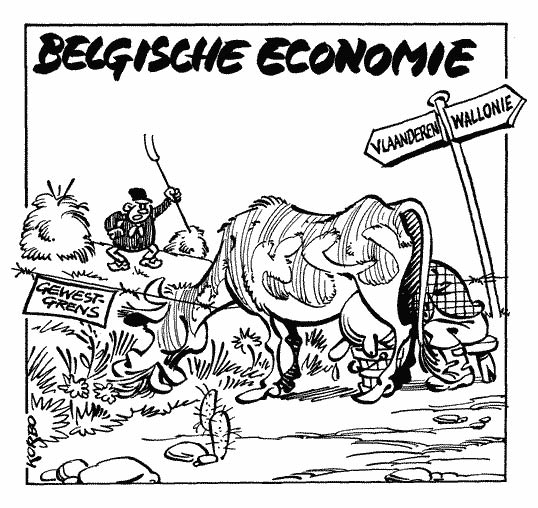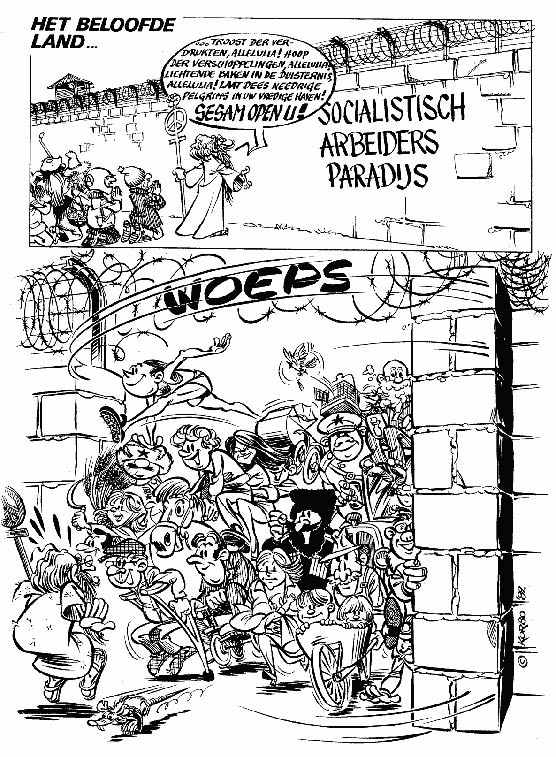Gag comic by Stan Sluydts. Translation: "You're overworked. What's your profession?" - "Anarchist!" - "I see. It's best to not throw bombs around for a week or three."
Stan Sluydts (often misspelled as "Stan Sluyts") is a Belgian cartoonist, illustrator and designer, who spent many years working for a large publishing firm. Between 1970 and 1973, he assisted the comic artist Erik Vandemeulebroucke on his story production for Kauka Verlag. Under the pseudonyms Gommer, Korbo and Prik, he was a propaganda cartoonist for several far-right and Flemish-nationalist publications. His cartoons were also reprinted in similar magazines in other European countries. Starting in 1979, Sluydts became one of the propaganda cartoonists for the far-right party Vlaams Blok (nowadays Vlaams Belang).
Early life and career
Stan Sluydts was born in 1940 in the Brussels municipality Etterbeek. His artistic family later moved to Lier, not far from Antwerp. His maternal grandfather was fine art painter Frans Torfs (1904-1973). Among his main graphic inspirations was Hergé. At the age of 14, Sluydts had his first job with a lithographic print shop in Brussels. He later worked for a newspaper, as decoration designer for a textile screen printing firm and, from 1969 on, as cartographer in the Geographic Institute of the University of Leuven. In the early 1970s, Sluydts settled in Antwerp, where he worked as an illustrator, advertising artist and logo designer.
By 1971, Sluydts began working for Erik Vandemeulebroucke, a Flemish comic artist whose studio produced comics for German comic publisher Rolf Kauka, including the western feature 'Tom und Biberherz' and funny animal stories with 'Fix und Foxi'. Among Vandemeulebroucke's other co-workers at the time were André Donders, Guido de Vogel and Hugo de Sterk. From the studio's 1973 dissolvement until 1991, Sluydts worked as a poster artist, graphic designer and publicity and editorial illustrator for the promotion service of a large magazine publishing and distribution firm. As a comic artist, cartoonist, illustrator and graphic designer, he did freelance assignments for publishing firms, manufacturers and individual clients.
Cartoon by Stan Sluydts, depicting Belgian economy as a cow in Wallonia, eating grass in Flanders.
Far-right cartoons
Stan Sluydts was most notable as a propaganda cartoonist and illustrator for various ultra-conservative and nationalist publications. He was a member of the far-right, Catholic youth organization Algemeen Diets Jeugdverbond (1949-1961), which advocated unification of Flanders and The Netherlands. He remained a lifelong Flemish-nationalist with racist opinions. Many of his cartoons expressed ultra-Catholic, white-supremacist, antisemitic, pro-colonialist and pro-apartheid viewpoints, while opposing the political left, abortion, socialism, communism, immigration and environmentalism. He mostly worked under pseudonyms, of which "Gommer", "Korbo" and "Prik" were the most common.
His cartoons ran in far-right, neo-Fascist and neo-Nazi publications like EG: Europa Een (1965), Europapost (1966-1970), De Anderen (1967-1968), Alarm (1974-1977), Le Nouvel Europe Magazine (1975-1977), Haro (1977-1978), Austrian Aktuell/Sieg (1978), Vlaams Blok/Inzet (1980-1986), West Magazine (1981-1983), Revolte (1984 et 2010), De Jonge Geus (1985), Forces Nouvelles (1990-1991), Ket (1996-1999), Nation (2000-2001), Polémique (2002-2003) and the conservative, Flemish-nationalist, satirical weekly 't Pallieterke (2005, 2006-2009). Since 2001, they have appeared online on websites like Belhamel and 't Scheldt.
A 1979 episode of 'Haro Nieuwsdienst', published in the far-right magazine Haro. The second image caricatures Flemish politician Hugo Schiltz, the third image U.S. President Jimmy Carter and the fourth image philosopher Jean-Paul Sartre and actress Brigitte Bardot. Note the misspelling of the words "joernalisten" (should be: "journalisten") and "Persisch" (should be: "Perzisch"), which are quite odd mistakes for a publication advocating the Dutch language in Belgium...
As "Prik", Sluydts first appeared in the November 1974 issue of Alarm, the monthly magazine of the far-right Flemish-nationalistic militant order VMO (Vlaams Militante Orde). He mostly contributed stop comics and one-pagers. In 1977, Sluydts and other members of Alarm were alarmed that the magazine wasn't extreme enough. They promptly established another monthly magazine, Haro. In its pages, Sluydts contributed a comic page presented as a TV journal, titled 'Haro Nieuwsdienst'. In each episode, he presented a satirical view of current affairs and politics, through an ultra-conservative, Flemish-nationalist and often racist point of view. Starting in the 1980s, Sluydts' cartoons also appeared in the low-budget publication Inzet. Meanwhile, the VMO was legally banned in 1981 after many violent and vandalist actions and for being a private militia. Several members were sentenced to jail.
Work by Korbo and Prik work was reprinted in foreign far-right publications such as La Voce della Fogna in Italy (1980), Gäck in Germany (1980-1984), Le Rat Noir in Switzerland (1980-1984), Victoire and Aktuell in Austria (1978-1988), La Voz de la Rata Negra in Spain and L'Immonde and Pas de Panique à Bord in France (1993). Other publications copied or plagiarized the cartoonist's work. Many of Prik's cartoons featured a cameo of his wife, Gerarda.
Prik's Haro comic strips were not-so-subtly imitated and occasionally plagiarized by R.H. Edwards as 'Leagueorama' in the British far-right magazine League Review. Work by Korbo/Prik/Gommer was collected in the comic album 'Kraaiepoten' (1978), which also featured work by Jack Marchal and Julius. Copies of this comic book were confiscated by the Belgian Investigation Service during a raid at Haro's printing shop. A second collection appeared in 1984 under the title 'De Schizofreaken', followed by a French album 'Glasnost C'est Pour Quand...à l'Ouest?' in 1990.
1989 cartoon by Stan Sluydts, expressing how respectively the United States, Jews, Central Europe and capitalism regard Russian leader Mikhail Gorbachev's social reform program "glasnost".
Vlaams Blok/Belang
In 1979, the Flemish-nationalist, far-right party Vlaams Blok (nowadays Vlaams Belang) was founded. From 1980 on, Sluydts became one of their propaganda cartoonists and was in charge of many of their campaigns. He had the questionable honor of designing the party's notoriously racist "It's Good To Be White" stickers, which were handed out during demonstrations and party meetings. Sluydts also illustrated the controversial pamphlet 'De Meester Doet Het Weer', part of a campaign launched on 13 March 1989. With the pamphlet, Vlaams Blok wanted to encourage pupils to report teachers with "left-wing opinions" to them, particularly if said teachers criticized racism and drew comparisons between their party and Nazism. The party would then collect all this information and publish it in a black book. The campaign sparked national outrage, although novelist Tom Lanoye sarcastically claimed it was a "great idea". In his weekly editorial in Humo magazine, he called for readers to write as many fictitious letters to the party headquarters as they could. Within a few weeks, hundreds of letters flooded their offices. Vlaams Blok had their hands full reading each and every one of them, let alone determining whether they were real or not. Eventually they only considered ten copies to be genuine, way too little to collect in a book. As a result, the entire campaign failed.
In 1999, Korbo made a comic strip about Vlaams Blok politician Johan Demol. Demol was a former police chief, who was fired from his job because of his previous association with the Walloon far-right militia Front de la Jeunesse. During the 1999 elections, the man went into politics as Vlaams Blok party leader in the Brussels Regional Parliament. As part of their campaign, the party commissioned Korbo to create a comic strip about Demol. The booklet treated the man's dubious past in the militia in one single panel, in which his membership was diminished and romanticized as part of a love story. Nevertheless, Demol left the party in 2010 after they lost the previous two elections with disastrous results.
Written contributions
In 1981, Sluydts wrote a study about far-right-wing comics for issue #26 of Flemish comic news magazine Ciso Stripgids. However, a large chunk of his contribution was basically a rant against the political left and its political correctness "who ruin comics", as opposed to the political right, whose outdated, conservative, racist and sexist viewpoints apparently couldn't do wrong in his opinion. When he eventually got to the point of his article, he wrote an overview of various far-right comic artists and cartoonists. Since it wasn't known that he was active under various pseudonyms, he took the opportunity to praise his own work. He described Prik's comics as "good-natured gags and quality work", of which the "virtuoso art" contains a lot of "truthful elements and symbolism".
Between 1995 and 1996, Sluydts also wrote articles for the French fanzine Bédésup about (supposed) hidden masonic aspects in Hergé's World War II work. Yet he never explained why a supposed member of a secret society would hide clues and symbolism in a comic strip that would only draw attention to something this society wants to keep hidden...
1988 cartoon by Stan Sluydts. Left-wing people want to cross to the "socialist workers' paradise" behind the Berlin Wall, only to be surprised by numerous people from behind the wall wanting to flee to the West.







